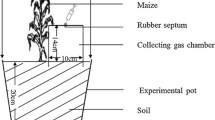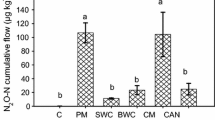Abstract
Manipulating the N release from high-N crop residues by simultaneous mixing of these residues with organic biological waste (OBW) materials seems to be a possible method to reduce NO3− leaching. The aim of this study was to examine whether the incorporation of OBW materials together with a high-N crop residue (celery) had also an effect on N2O emission from horticultural soil under short-term and optimised laboratory conditions. A sandy loam soil and celery residues were mixed with different OBW materials and brought into PVC tubes at 80% water-filled pore space and 15°C. Every 2.5 h, a gas sample was taken and analysed by gas chromatography for its N2O concentration. The soil amended with only celery residues had a cumulative N2O emission of 9.6 mg N kg−1 soil in 50 h. When the celery residues were mixed with an OBW material, the N2O emission was each time lower than the emission from the celery-only treatment (between 3.8 and 5.9 mg N kg−1 soil during maximum 77 h), except with paper sludge (17.2 mg N kg−1 soil in 100 h). The higher N2O emission from the paper sludge treatment was probably due to its unusually low C:N ratio. Straw, green waste compost 1 (GWC1) and 2 (GWC2), saw dust, and tannic acid reduced the N2O emission of the celery treatment by 40 to 60%. Although the N2O reduction potential can be expected to be lower and with differing dynamics under field conditions, this study indicates that apart from reducing NO3− leaching, OBW application may at the same time reduce N2O emissions after incorporation of high-N crop residues.


Similar content being viewed by others
References
Aitken MN, Evans B, Lewis JG (1998) Effect of paper mill sludge to arable land on soil fertility and crop yield. Soil Use Manage 14:215–222
Anonymous (1991) Decree of 23rd of January 1991 concerning the protection of the environment against the pollution by fertilizers. Belgian Statute Book 28.02.1991, N91-535, pp 3829–3838
Aulakh MS, Rennie DA (1987) Effect of wheat straw incorporation on denitrification of N under anaerobic and aerobic conditions. Can J Soil Sci 67:825–834
Aulakh MS, Doran JW, Walters DT, Moiser A, Francis DD (1991) Crop residue type and placement effects on denitrification and mineralization. Soil Sci Soc Am J 55:1020–1025
Baggs EM, Rees RM, Smith KA, Vinten AJA (2000a) Nitrous oxide emission from soils after incorporating crop residues. Soil Use Manage 16:82–87
Baggs EM, Watson CA, Rees RM (2000b) The fate of nitrogen from incorporated cover crop and green manure residues. Nutr Cycl Agroecosyst 56:153–163
Baggs EM, Rees RM, Castle K, Scott A, Smith KA, Vinten AJA (2002) Nitrous oxide release from soils receiving N rich crop residues and paper mill sludge in eastern Scotland. Agric Ecosyst Environ 90:109–123
Bending GD, Read DJ (1996) Effects of the soluble polyphenol tannic acid on the activities of ericoid and ectomycorrhizhal fungi. Soil Biol Biochem 28:1595–1602
Bijay-Singh, Ryden JC, Whitehead DC (1988) Some relationships between denitrification potential and fractions of organic carbon in air-dried and field-moist soils. Soil Biol Biochem 20:737–741
Capasso R, Evidente A, Schivo L, Orru G, Marcialis MA, Cristinzo G (1995) Antibacterial polyphenols from olive oil mill waste waters. J Appl Bacteriol 79:393–398
Cicerone RJ (1987) Changes in atmospheric ozone. Science 237:35–42
De Neve S, Hofman G (1996) Modelling N mineralization of crop residues during laboratory incubations. Soil Biol Biochem 28:1451–1457
De Neve S, Gaona Sáez S, Chaves Daguilar B, Hofman G (2004) Managing N release from high-N crop residues using on- and off-farm organic materials. Soil Biol Biochem 36:127–134
D’Haene K, Moreels E, De Neve S, Chaves Daguilar B, Boeckx P, Hofman G, Van Cleemput O (2003) Soil properties influencing the denitrification potential of Flemish agricultural soils. Biol Fertil Soils 38:358–366
Doran JW, Mielke LN, Stamatiadis S (1990) Microbial activity and N cycling as regulated by soil water-filled pore space. In: Proceedings 11th Conference of the International Soil and Tillage Research Organisation, vol. 1, pp 49–54
Fox RH, Myers RJK, Vallis I (1990) The nitrogen mineralization rate of legume residues in soil as influenced by their polyphenol, lignin, and nitrogen contents. Plant Soil 129:251–259
Hao X, Chang C, Carefoot JM, Janzen HH, Ellert BH (2001) Nitrous oxide emissions from an irrigated soil as affected by fertilizer and straw management. Nutr Cycl Agroecosyst 60:1–8
Hewlett TE, Hewlett EM, Dickson DW (1997) Response of Meloidogyne spp., Heterodora glycines, and Radopholus similes to tannic acid. J Nematol 29:737–741
Hill AR, Cardaci M (2004) Denitrification and organic carbon availability in riparian wetland soils and subsurface sediments. Soil Sci Soc Am J 68:320–325
Jensen ES (1994) Mineralization–immobilization of nitrogen in soil amended with low C:N ratio plant residues with different particle sizes. Soil Biol Biochem 26:519–521
King HGC, Heath GW (1967) The chemical analysis of small samples of leaf material and the relationship between the disappearance and composition of leaves. Pedobiologia 7:192–197
Linn DM, Doran JW (1984) Aerobic and anaerobic microbial populations in no-till and plowed soils. Soil Sci Soc Am J 48:794–799
Moorhead KK, Graetz DA, Reddy KR (1988) Mineralization of carbon and nitrogen from freeze- and oven-dried plant material added to soil. Soil Sci Soc Am J 52:1343–1346
Mosier AR, Schimel DS (1991) Influence of agricultural nitrogen on atmospheric methane and nitrous oxide. Chem Indust 23:874–877
Rahn CR, Vaidyanathan LV, Paterson CD (1992) Nitrogen residues from Brassica crops. Asp Appl Biol 30:263–270
Rahn C, Bending GD, Turner MK, Lillywhite R (2003) Management of N mineralization from crop residues of high N content using amendment materials of varying quality. Soil Use Manage 19:193–200
Renault P, Stengel P (1994) Modelling oxygen diffusion in aggregated soils: 1. Anaerobiosis inside the aggregates. Soil Sci Soc Am J 58:1017–1023
Scalbert A (1991) Antimicrobial properties of tannins. Phytochemistry 30:3875–3883
Schloemer S (1991) Denitrifikation eines gemüsebauchlich genutzten Bodems in Abhängigkeit von der Einarbeitung frischer Erntereste. Z Pflanzenernähr Bodenkd 154:205–209
Sörensen JN (1992) Effect of catch crops on the content of soil mineral nitrogen before and after winter leaching. Z Pflanzenernähr Bodenkd 155:61–66
Stanford G, Vander Pol RA, Dziena S (1975) Denitrification rates in relation to total and extractable soil carbon. Soil Sci Soc Am J 39:284–289
Stevens RJ, Laughlin RJ (1998) Measurements of nitrous oxide and di-nitrogen emissions from agricultural soils. Nutr Cycl Agroecosyst 52:131–139
Stevens RJ, Laughlin RJ, Burns LC, Arah JRM, Hood RC (1997) Measuring the contributions of nitrification and denitrification to the flux of nitrous oxide from soil. Soil Biol Biochem 29:139–151
Velthof GL, Kuikman P, Oenema O (2002) Nitrous oxide emission from soils amended with crop residues. Nutr Cycl Agroecosyst 62:249–261
Vigil MF, Kissel DE (1991) Equations for estimating the amount of nitrogen mineralized from crop residues. Soil Sci Soc Am J 55:757–761
Vinten AJA, Davies R, Castle K, Baggs EM (1998) Control of nitrate leaching from a nitrate vulnerable zone using paper mill waste. Soil Use Manage 14:44–51
Weier KL, Doran DW, Power JF, Walters DT (1993) Denitrification and the dinitrogen/nitrous oxide ratio as affected by soil water, available carbon and nitrate. Soil Sci Soc Am J 57:66–72
Acknowledgements
The authors wish to express their thanks to the Belgian Ministry of Small Enterprises and Traders and Agriculture, Division of Research and Development, for funding this research (project S-6059). We also thank M. Remue, V. Van De Vyvere, L. Bauwens, T. Coddens and S. Schepens for their skilful technical assistance.
Author information
Authors and Affiliations
Corresponding author
Rights and permissions
About this article
Cite this article
Chaves, B., De Neve, S., del Carmen Lillo Cabrera, M. et al. The effect of mixing organic biological waste materials and high-N crop residues on the short-time N2O emission from horticultural soil in model experiments. Biol Fertil Soils 41, 411–418 (2005). https://doi.org/10.1007/s00374-005-0853-8
Received:
Revised:
Accepted:
Published:
Issue Date:
DOI: https://doi.org/10.1007/s00374-005-0853-8




